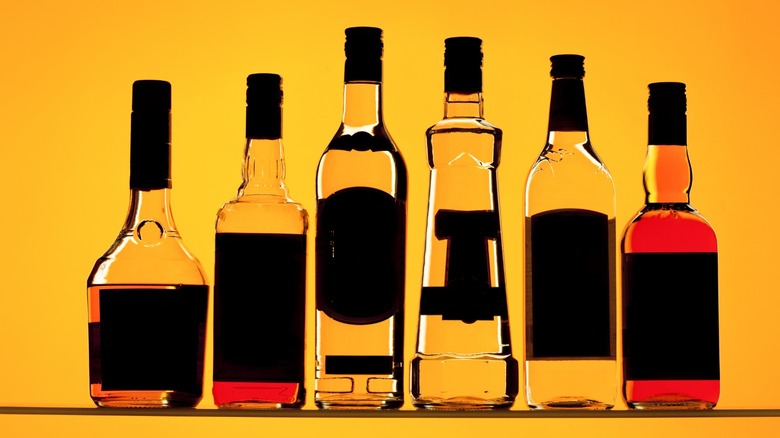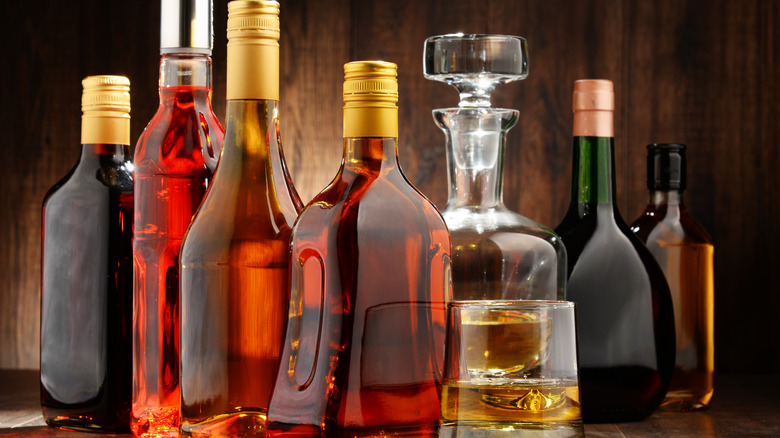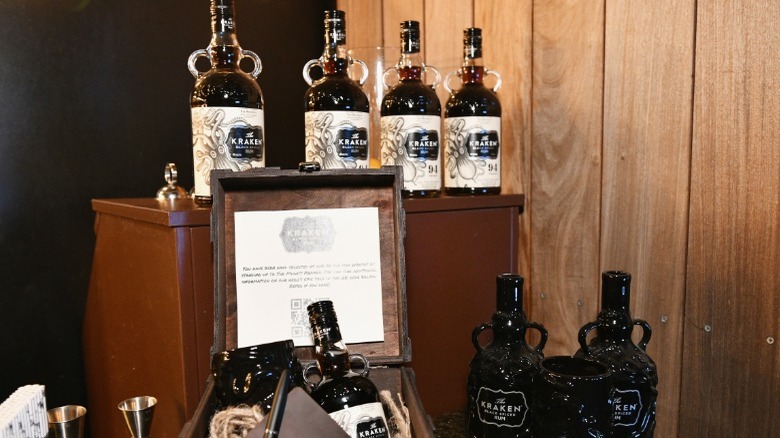Why Liquor Bottles Come In So Many Different Shapes
While wandering the aisles of your local liquor store in search of the one spirit needed to create your next cocktail masterpiece, you may have noticed that liquor bottles aren't always made alike. Even among the same kinds of liquor, bottle shapes, sizes, and designs can vary greatly. As it turns out, there are a number of reasons for this.
The primary factor behind the shape of liquor bottles has everything to do with bartender ergonomics. In a bar, the bottles are placed in various locations — you may have heard the teams "well," "bottom shelf," or "top shelf" to describe different liquors. For bartenders, bottles that have a curved shape to them are easier to grab off of higher shelves. Additionally, it's better for bottles that live in the well to have a beveled neck so that they can be easily picked up.
Properly handling the bottle is essential, as one bartender told Liquor.com: "To have the bottle balanced on the back of your hand, between your fingers, getting eye level to the pour, is one of the most natural feelings you can get behind the bar."
Do bottle shapes change based on the type of alcohol?
So a bottle's shape has something to do with where it may be located behind the bar, but does shape also change based on if the liquor is rum, tequila, or vodka? For alcohols where the craft is traditionally very important, more rounded bottle shapes are common. This includes liquors like rum, whiskey, brandy, and cognac. Hennessy's XO Cognac bottle has a particularly unique and curvy shape, and is apparently meant to mimic a bunch of grapes when you turn it upside down to pour.
Generally, there are certain spirits whose bottles follow a similar pattern. Vodka bottles are typically clear and fairly simple, which highlights the transparency of the vodka itself as well. For whisky, the bottle is meant to represent the elegance of the liquor. Traditional whiskey bottles have a solid base with a long neck. Rum bottles are often a fun reflection of the Caribbean culture that created the liquor — Malibu Coconut Rum, for example, has a white, curved bottle that features a palm tree motif.
Some designs truly stand out from the crowd
Sometimes, the bottle's appearance is less about function, and more about aesthetics. Obviously, the bottle is an integral part of marketing the liquor inside, but some brands can get really creative when it comes to design. One tequila brand called Patsch produces blanco, reposado, and añejo tequilas that come in bottles with a handle that looks like brass knuckles. The bottle itself has a long, thin neck and round bottom — think those erlenmeyer flasks from your high school chemistry class — and the cap has three spikes on it like a crown. The company's cofounder and bottle designer said he was inspired by fashion designer Alexander McQueen, and his expensive taste is reflected in the cost of the bottle — the añejo goes for $150 for 750 milliliters.
Investing in bottle design actually pays off for a lot of brands in the long run. One design firm, Stranger & Stranger, has iconic liquor brand clients like Jack Daniel's and has taken on design projects for newer brands as well. For the relatively new label Kraken, the firm created the entire brand from scratch with eye-catching, kraken tentacle-covered bottles, and it is now worth over $1 billion. In fact, one of their redesign projects for Aberfeldy Scotch led to a year's worth of the liquor selling in only three months. It's evident that the more striking the bottle, the more it'll sell.



